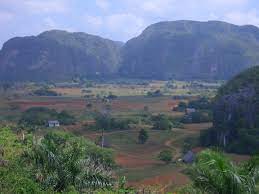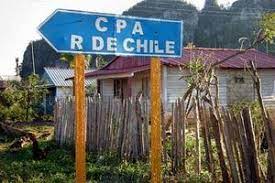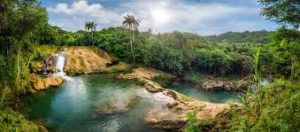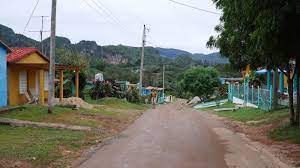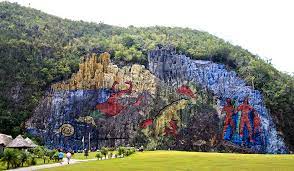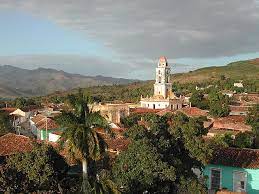REPUBLICA DE CHILE (VIÑALES), CUBA. ZONA QUE SE DENOMINA “LAGUNA DE PIEDRA”. PHOTOS
República de Chile es el nombre con que se denomina a una localidad del municipio de Viñales, en la provincia de Pinar del Río, en el extremo occidental de Cuba. Y fue proclamada con este nombre por el gobierno de Cuba en memoria del presidente de Chile Salvador Allende.
La zona referida recibía y recibe el nombre de “Laguna de Piedra” enclavada en el municipio de Viñales, Provincia de Pinar del Río, limita al norte con la Mina de la Constancia, al oeste con San Vicente, al este con el Yayal y al sur con las Alturas de Pizarra del Sur.
Se encuentra en las coordenadas 22°39’45.22″N, 83°40’33.43″O, a 5,5 km al noreste de la ciudad de Viñales —en línea recta—; por ruta asfaltada, la distancia es de 7,1 km. Se sitúa al pie del grupo montañoso de la cordillera de Guaniguanico, en la Sierra de los Órganos.
La zona está caracterizada por valles intramontanos encerrados por elevaciones montañosas que forman parte de la Sierra de los Órganos y presenta generalmente suelos alomados y ondulados.
Comunidad enclavada a unos 7 Km del municipio de Viñales. En esta comunidad se creó la primera Cooperativa de Producción Agropecuaria (CPA) de su tipo en Cuba cuando aún no se había trazado la línea de trabajo del movimiento cooperativo en el país. Esta cooperativa, mediante técnicas de producción ecológicas, produce hortalizas aprovechando aguas de manantiales.
Administrativamente es un Consejo Popular, uno de los siete con que cuenta el municipio de Viñales.
ECONOMIA
Los principales rubros económicos son la agricultura, pues se cosecha frutas, verduras, café y especialmente tabaco logrado por métodos tradicionales, así como la ganadería, tanto para carne como de lechería tropical.
El turismo es otro ítem destacado de la zona, pues la región en donde está situada esta localidad fue declarada en 1999 como Parque nacional, y en diciembre de ese mismo año fue nombrado por la Unesco como el Patrimonio Natural de la Humanidad Valle de Viñales.
Entre los atractivos muy próximos a la localidad destacan varias cuevas kársticas, entre ellas la cueva del Palmarito. También sobresale el Mural de la Prehistoria, obra de Leovigildo González Morillo, el cual está pintado sobre una pared de piedra del mogote Pita; muestra la evolución de la vida natural en Cuba. Su tamaño es de 120 por 160 metros de longitud.
Al fundarse la organización campesina ANAP en el 1961, se forma inicialmente en nuestra zona una sola cooperativa denóminada “Juan Manuel Marquéz”. Posteriormente en 1963 se subdividió en 4 cooperativas. Estas Cooperativas de Créditos y Servicios (CCS) tomaron el nombre de Agusto Cesar Sandino, Antonio Guiteras, Julio A. Mella y Juan Manuel Marquéz.
En el año 1964 fue necesario dividir esta última surgiendo la cooperativa Julian Grimau. La economía está sustentada fundamentalmente en la actividad agrícola que se basa en cultivos varios y la producción de tabaco.
EDUCACION
El sector educacional cuenta con tres escuelas primarias. Cuenta tambien con un programa Educa a tu hijo.Como complemento a la educación de todos los sectores de la población.
Para los servicios de salud existen 4 consultorios del Médico de la Familia
La distribución deportiva está enmarcada en la institución educacional en este caso la escuela primaria, los deportes fundamentales son el Voleibol, Ajedrez, Fútbol y Baloncesto.
REPUBLIC OF CHILE (VIÑALES), CUBA. AREA CALLED “LAGUNA DE PIEDRA”. PHOTOS
The Republic of Chile is the name given to a town in the municipality of Viñales, in the province of Pinar del Río, in the western end of Cuba. And it was proclaimed with this name by the government of Cuba in memory of the president of Chile Salvador Allende.
The aforementioned area received and continues to receive the name “Laguna de Piedra” located in the municipality of Viñales, Province of Pinar del Río, bordered to the north by the Mina de la Constancia, to the west by San Vicente, to the east by Yayal and to the south with the South Slate Heights.
It is located at coordinates 22°39’45.22″N, 83°40’33.43″W, 5.5 km northeast of the city of Viñales —in a straight line—; by paved road, the distance is 7.1 km. It is located at the foot of the mountain range of the Guaniguanico mountain range, in the Sierra de Los Órganos.
The area is characterized by intermontane valleys enclosed by mountainous elevations that form part of the Sierra de Los Órganos and generally have hilly and undulating soils.
The community is located about 7 km from the municipality of Viñales. The first Agricultural Production Cooperative (CPA) of its kind in Cuba was created in this community when the line of work of the cooperative movement in the country had not yet been drawn up. This cooperative, using ecological production techniques, produces vegetables using spring water.
Administratively it is a Popular Council, one of the seven that the municipality of Viñales has.
ECONOMY
The main economic items are agriculture, as fruits, vegetables, coffee, and especially tobacco are harvested by traditional methods, as well as livestock, both for meat and tropical dairy.
Tourism is another outstanding item in the area since the region where this town is located was declared a National Park in 1999, and in December of that same year, it was named by UNESCO as the Viñales Valley Natural Heritage of Humanity.
Among the attractions very close to the town, several karstic caves stand out, including the Palmarito cave. Also outstanding is the Mural of Prehistory, the work of Leovigildo González Morillo, which is painted on a stone wall of the Pita mogote; shows the evolution of natural life in Cuba. Its size is 120 by 160 meters in length.
When the peasant organization ANAP was founded in 1961, a single cooperative called “Juan Manuel Marquéz” was initially formed in our area. Later in 1963, it was subdivided into 4 cooperatives. These Credit and Services Cooperatives (CCS) took the name of Agusto Cesar Sandino, Antonio Guiteras, Julio A. Mella and Juan Manuel Marquéz.
In 1964 it was necessary to divide the latter, with the emergence of the Julian Grimau cooperative. The economy is fundamentally based on agricultural activity based on various crops and tobacco production.
EDUCATION
The educational sector has three primary schools. It also has an Educate your child program. As a complement to the education of all sectors of the population.
For health services, there are 4 Family Doctor offices
The sports distribution is framed in the educational institution, in this case, the primary school, the fundamental sports are Volleyball, Chess, Soccer, and Basketball.
Agencies/ Wiki/ Ecured/ Extractos/ Excerpts/ Internet Photos/ Arnoldo Varona/ www.TheCubanHistory.com
THE CUBAN HISTORY, HOLLYWOOD.



